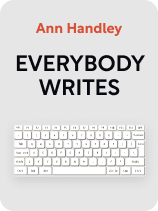

This article is an excerpt from the Shortform book guide to "Everybody Writes" by Ann Handley. Shortform has the world's best summaries and analyses of books you should be reading.
Like this article? Sign up for a free trial here.
How should the writing process start? How many drafts should you write? What should your first draft accomplish?
In Everybody Writes, Ann Handley discusses what elements to include in your writing and how to write for different formats. Then she gets down to the nitty-gritty of the practical writing process. She recommends writing four drafts.
Keep reading for Handley’s advice on how to write a first draft.
How to Write a First Draft
As Handley explains how to write a first draft, she recommends beginning with identifying what format you want to write in, what purpose it will serve for the audience, and what structure will best fit your piece. It can help to make a list of everything you want to cover and then see how you can best organize these ideas.
(Shortform note: The steps Handley lists are often included in guidelines for how to write an outline for a piece of writing. Whether or not to outline your work—and how detailed you make your outline—is a matter of personal preference, but outlines can help you form and follow a roadmap for what you’re creating and can be particularly helpful in collaborative writing. Consider whether you want to create a thorough outline of your work before you begin drafting, but always be willing to change the outline as needed.)
Next, gather any information from outside sources that you may need, and be sure to cite them when you write. In selecting sources to use, try to find primary sources instead of secondary. Secondary sources might have hidden biases or misinterpretations, and getting your information straight from the primary source prevents you from perpetuating these and makes your writing more credible.
(Shortform note: While primary sources are ideal for gathering information like raw data, secondary sources can be useful for synthesizing information from multiple sources or establishing background information. As long as you assess your secondary sources for reliability, you don’t need to avoid them entirely, and you may find them just as important as your primary sources depending on what you’re writing.)
Additionally, try to find recent sources for facts and data, as information can change rapidly, and you don’t want to misrepresent any facts in your piece. Keep track of your sources as you go, and create formal citations as needed. If you try to do all of this at the end of your writing process, you may forget what information you got from other sources and accidentally plagiarize them.
(Shortform note: Many people who are caught plagiarizing claim that it was accidental, and sometimes it is, but, more often it is a matter of negligence. Accidental plagiarism may include things like mixing up citations between sources or failing to cite a fact because you assumed it was common knowledge. However, repeated plagiarism of the same source or failing to sufficiently rewrite information from a source is negligent. Mistakes are often unavoidable, but negligence is not, and citing your sources as you go is one of the easiest ways to avoid negligence.)
Next, draft your piece—Handley recommends writing four drafts. The first is your rough draft, which she emphasizes will not look good. This draft is just about getting your ideas on the page (or the screen), and you don’t need to spend time focusing on things like correct grammar or complete sentences. Once finished, she recommends stepping away from this draft for a while before coming back for the next one
(Shortform note: The idea of writing anything that doesn’t immediately look good can be frightening and discouraging, especially if your ultimate goal is to share the writing with others through publication. Instead of expecting to write a bad draft, some experts suggest thinking of this as writing an easy draft. If you hit an obstacle, try asking yourself what would make this next step easy. Your draft will still be rough, but it may be easier to motivate yourself if you reframe it as easy rather than bad.)

———End of Preview———
Like what you just read? Read the rest of the world's best book summary and analysis of Ann Handley's "Everybody Writes" at Shortform.
Here's what you'll find in our full Everybody Writes summary:
- Why there is no such thing as a bad writer
- A guide to improving your writing and reaching your audience
- How to adapt your writing to different formats while maintaining your voice






